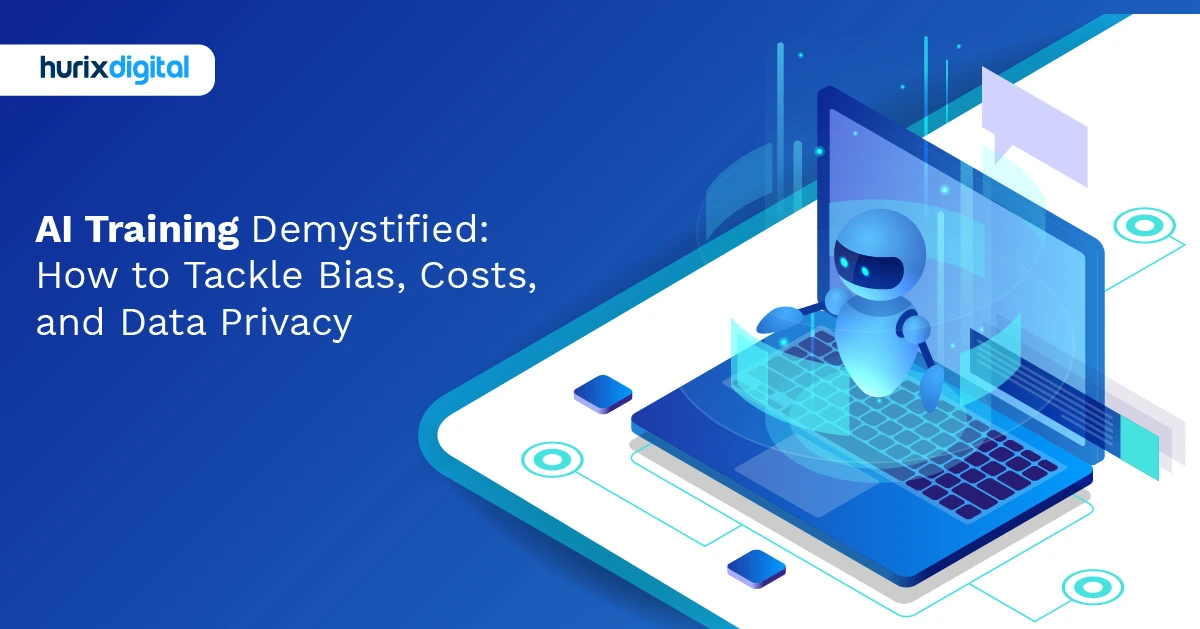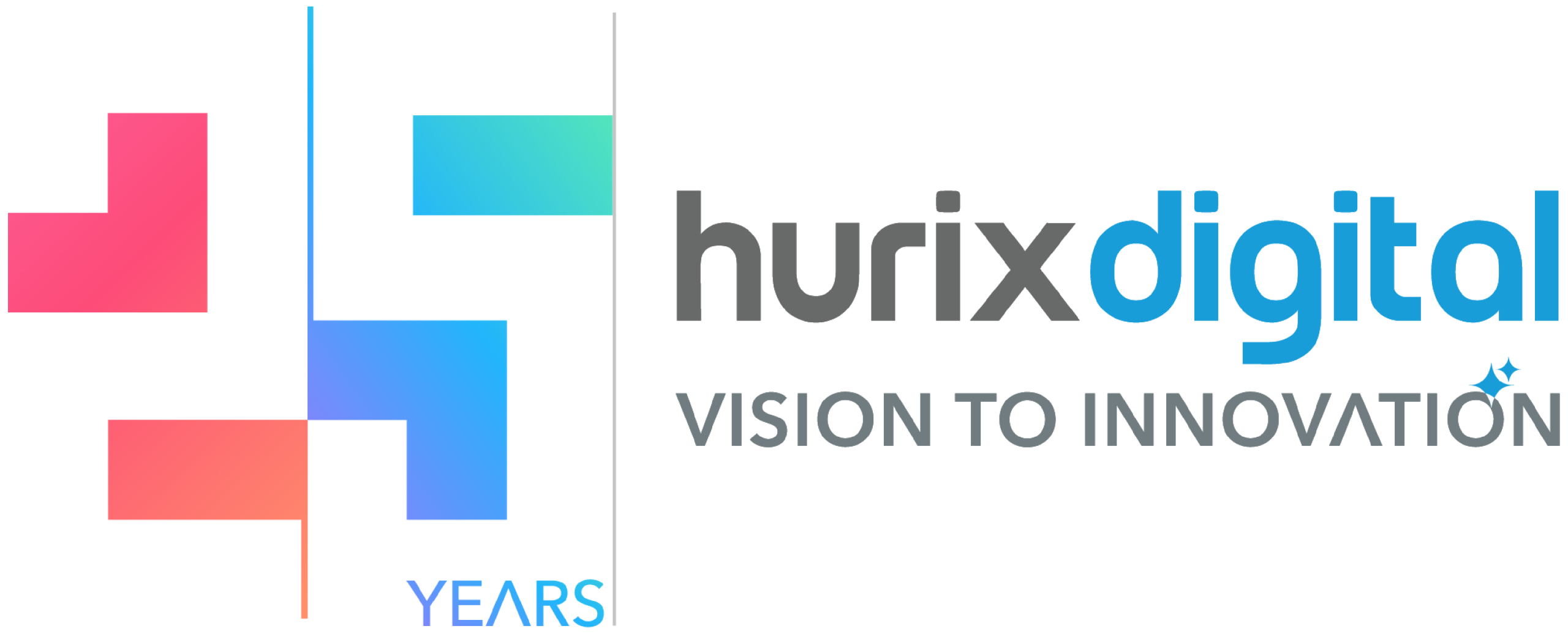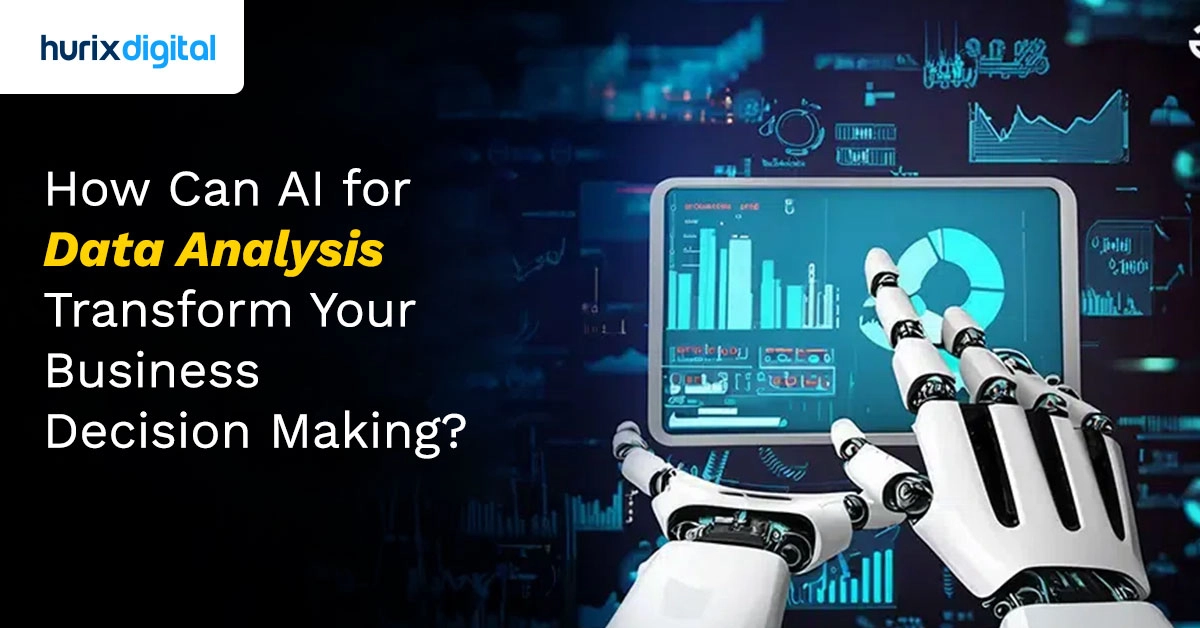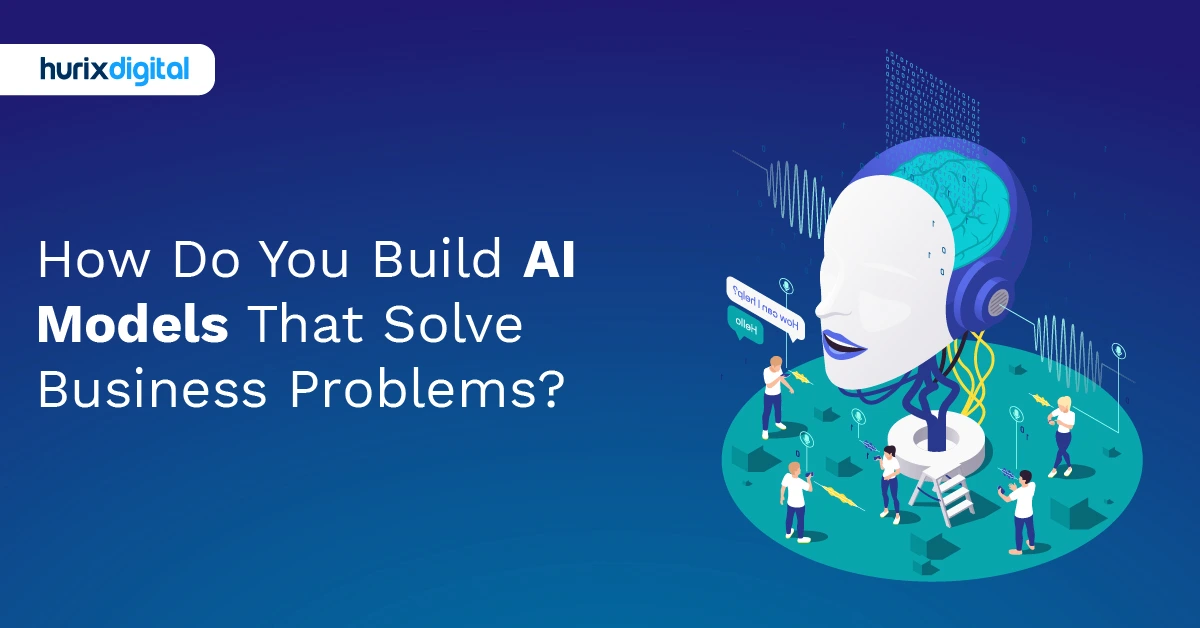
AI Training Demystified: How to Tackle Bias, Costs, and Data Privacy
Summarize with:
AI is not magic, it’s math. And it works on a mountain of data. But turning that data into a useful AI model? That’s where things get interesting. Honestly, sometimes it’s a little messy too. Having spent years working on different AI projects, we have seen firsthand the challenges leaders face. There’s a tangle of data, a black box of infrastructure, and ethical issues to consider. Getting the right model is a challenging experience.
So, how do you navigate this complex landscape? What are the right questions to ask before diving headfirst into AI training? This article tackles 10 critical questions that every leader should be asking. We’ll look at issues like cleaning messy data, teaching an unbiased algorithm, trimming costs, proving return on investment, and keeping customer info private. With this blog serving as a guiding light, you’ll be enlightened about designing a fair, accurate, and business-relevant AI system.
Table of Contents:
- What Are the Biggest Data Challenges in AI Training Today?
- How to Choose the Right AI Training Infrastructure?
- What Are the Best Strategies for Mitigating AI Bias?
- How to Optimize AI Training Costs Without Sacrificing Accuracy?
- How To Measure the ROI of AI Training Investments?
- What Innovative AI Training Techniques Are Emerging Currently?
- How to Ensure Data Privacy During AI Model Training Phases?
- What Skills Are Vital for My AI Training Team’s Success?
- How Can I Scale AI Training Across My Organization Effectively?
- What Are the Crucial Legal Considerations Around AI Training Data?
- A Final Word
What Are the Biggest Data Challenges in AI Training Today?
Okay, so where do AI projects often stumble? It’s almost always about the data, right? We assume that the algorithms work like magic, but honestly, garbage in, garbage out applies here too.
Think about it. One major headache is simply getting enough data. So, there was this computer vision project we took a few months ago. We wanted to train an AI to spot defects on a production line. Sounds simple, right? Wrong. We had thousands of good examples, but barely any of the bad. The AI became an expert at recognizing perfect parts, completely useless at catching flaws. That’s data scarcity hitting you hard.
Then, there is the entire data quality mess. The fact that you have data doesn’t mean they are good data. It may be inaccurately labeled, biased, or it may be altogether wrong. Consider the case of training a self-driving vehicle with all the pedestrians dressed in bright colors. What about the time when a person wears dark attire on a rainy day? That would be a disaster.
How to Choose the Right AI Training Infrastructure?
Choosing the AI infrastructure is like purchasing a car with blindfolds. There are too many choices, and the language is too technical, and getting it wrong may end up costing millions.
The first decision point is rarely discussed but is critically important: build versus buy versus hybrid. Building your own infrastructure offers maximum control but requires significant expertise.
Cloud solutions promise flexibility and scalability. AWS, Google Cloud, and Azure compete fiercely for enterprise AI workloads. But here’s what vendors won’t tell you: the ease of scaling up can lead to runaway costs. Auto-scaling features that seem convenient can trigger massive bills when improperly configured.
Hybrid approaches often work best for established enterprises. They keep sensitive data and core models on-premises while using cloud resources for experimentation and peak loads. A major bank uses this strategy effectively. Their customer data never leaves their data center. However, they rely on cloud computing for model training during off-peak hours.
Technical specificities are not as important as you may imagine. Certainly, you need proper computing power, but the distinguishing factors are ease of use, integration ability, and cost predictability. Intelligent organizations begin with a small step and prove the strategy, then expand little by little. They are also wary of negotiating contracts, and startup credits might be awfully tempting, with their lock-in terms.
Keep in mind that infrastructure is a solution. Simply put, the best infrastructure is the one your team can effectively use.
What Are the Best Strategies for Mitigating AI Bias?
Bias in AI isn’t just a technical problem. It’s a clear reflection of our own human biases. When we ignore it, whole communities can end up facing unfair treatment. The big question is, how do we push against that tide?
Start with data that looks like the real world. If your edtech AI only sees top-tier schools, it’ll flunk the rest. Tools can help. AI bias detectors flag skewed patterns early. Set fairness goals upfront: equal pass rates across demographics. Humans need to watch, too—experts who know education, not just code. Fairness algorithms can tweak outputs, but they’re not magic. We once caught a model docking points for non-Western names. Took a teacher’s eye to spot it.
Bias isn’t just tech, it’s ethics. Your AI’s decisions carry your company’s weight. Screw it up, and you’re not just wrong; you’re unfair. Keep asking: who’s this leaving out?
How to Optimize AI Training Costs Without Sacrificing Accuracy?
The training of AI models can seem like feeding a very hungry, very costly beast. You slug in the data, increase the computing capacity, and then wait for something cool to pop out. But imagine that you are able to tame a bit that monster and make it more efficient without taking away its intelligence. Why not? It is absolutely possible.
One of the first things I always look at is the data itself. Is it really necessary to feed the model everything? There was this project where we were predicting customer churn for an aviation company. We threw every piece of customer data we could find at the model, only to discover that a huge chunk of it was just noise. Spending time to clean, filter, and select the right data can dramatically reduce your training time. More than that, it will cut your cloud bills. Think quality over quantity, always.
Then there’s the choice of model architecture. Are you reaching for the biggest, fanciest neural network right out of the gate? It is often observed that a carefully-tuned simple model performs nearly identically with a small fraction of the compute. It is similar to a monster truck versus a sedan. Both may transport you from A to B, albeit one of them will consume a lot more fuel.
Another lesser-known cost-saver strategy is transfer learning. Why build a model from scratch when you can take a pre-trained one and fine-tune it for your specific task? It’s like giving your model a head start, allowing it to learn faster and with less data.
Still, transfer learning isn’t a miracle cure. Like almost any tool, its upside may bring along a small downside. There can also be too much trimming of data, resulting in underfitting. In the same way, choosing a model that is too small may miss the problem. It is important to keep paying attention to the business outcomes of your model and change your plans accordingly. There is nothing to be afraid of trying. It is possible to say that sometimes the most unexpected methods work best.
How To Measure the ROI of AI Training Investments?
So, you’ve put money and time into AI training. Great. Now comes the real question: What am I getting back? What’s the return on my investment, or ROI? The short answer is, it depends, and that’s part of the challenge.
First, think about what you were hoping to achieve with the training. Was it to improve customer service response times? Did you want to improve the accuracy of detecting fraud? Or maybe you were after something less tangible. Like, for example, improving employee satisfaction levels by automating tedious tasks? Be precise. This is your before picture.
Next, set some clear metrics. For customer service, you should track metrics like average handle time, customer satisfaction scores, and the number of issues resolved on first contact. For fraud detection, you should be looking at metrics like the reduction rate of fraudulent transactions and the decrease in false positives. And for employee satisfaction? Well, that’s trickier. Surveys and feedback are the way to go.
Now, after the training, measure those same metrics again. This is your after picture. The difference between the two, that’s your raw improvement. But, wait. Don’t stop there.
The hard part comes. Attaching a dollar value to your efforts. How much is each percentage point increase in customer satisfaction worth? How much money did you actually save by preventing those fraudulent transactions? This demands a little digging, a little guessing, and perhaps a touch of informed guesswork. There really is nothing to be fearful about being flawed. We have even spent weeks painstakingly doing all the calculations on how much money the business could save by using an AI-powered inventory system tool, only to then remember to answer the question, does AI-powered inventory management consume electricity? It happens.
Finally, factor in the cost of the AI training itself. This includes software licenses, hardware, data preparation, internal team time, external consultant fees, and so on. Then compare the improvement’s dollar value against the training cost. That’s your ROI.
What Innovative AI Training Techniques Are Emerging Currently?
Over the years, I have come to this conclusion. The AI training landscape shifts like desert sand. What’s revolutionary today becomes routine tomorrow. However, several techniques are reshaping how organizations approach model development.
Federated learning turns the idea of centralizing data upside down. Instead of bringing data to the model, bring the model to the data. One of our healthcare clients now trains diagnostic AI without sharing patient records. They train their AI locally, sharing only model updates. Privacy is preserved, and insights are multiplied. The technical challenges remain significant, but the potential for industries with sensitive data is enormous.
Few-shot and zero-shot learning tackle the data scarcity problem head-on. Instead of needing thousands of examples, models learn from a handful or even descriptions. A customer service AI that can handle new product categories without needing to be retrained. A manufacturing defect detector that recognizes new flaw types from verbal descriptions. It sounds like science fiction, but companies are deploying these techniques today.
How to Ensure Data Privacy During AI Model Training Phases?
Privacy is a tightrope. One misstep with data, and you’re penalized. Beyond penalties, you lose trust. That’s why keeping information safe while training AI demands grit and careful thinking.
Start data minimization before training. Question every data field. That customer’s full address might seem useful, but does your churn prediction model really need it? One of our clients reduced their privacy risk by 80% simply by thinking harder about what data they actually required. Less data means less risk, lower storage costs, and often faster training.
Differential privacy works by mixing a little noise into data so researchers can spot trends without knowing personal details. Picture it like gently smudging a group photo: the overall picture stays clear, but individual faces are tough to recognize. Apple uses it for iPhone analytics. Google for Chrome statistics. The trade-off? Slightly reduced model accuracy for significantly enhanced privacy. Most business use cases can tolerate this exchange.
Finally, access controls and audit trails seem boring, but they prevent disasters. Who can access training data? For how long? With what justification? A financial services firm discovered a data scientist had downloaded their entire customer database “for experimentation.” Strong controls would have prevented it.
What Skills Are Vital for My AI Training Team’s Success?
Building an AI team by collecting PhDs is like forming a band with only lead guitarists. Sure, they look impressive, but can they play together? The skills that matter might surprise you.
Statistical thinking trumps coding mastery. Understanding when a model is overfitting versus genuinely learning. Knowing which metrics matter for your business problem. Recognizing when the correlation isn’t causation.
Domain expertise bridges the gap between algorithms and impact. The best fraud detection models come from teams that understand both machine learning and financial crime. A pharmaceutical company’s AI drug discovery tool succeeded because biochemists worked alongside data scientists, translating molecular knowledge into model features. Pure technologists build impressive toys. Domain-informed teams build valuable solutions.
Ethical reasoning becomes non-negotiable as AI touches more lives. It’s not enough to build accurate models. Teams must anticipate misuse, understand bias, and consider societal impact. A hiring platform added an ethicist to their core team after realizing their engineers couldn’t see the discrimination risks in their approach. Technical skills build models. Ethical thinking ensures they do no harm.
How Can I Scale AI Training Across My Organization Effectively?
Scaling AI from proof-of-concept to production separates the dreamers from the doers. Most organizations nail the pilot project and then stumble when spreading success across departments. The graveyard of corporate AI initiatives is full of impressive demos that never scaled.
Knowledge-sharing mechanisms prevent wheel reinvention. Every team training model from scratch wastes resources and time. A manufacturing company developed an internal model registry not only code but also documentation, training data, needs, and lessons learned. It was based on their predictive maintenance model, which was adopted as the basis of quality control, the optimization of supply chains, and demand forecasting practices. The output of one team is spread throughout the organization.
Instead of centralized approval committees that become bottlenecks, create clear guidelines and automated checks. A financial institution implemented automated bias testing, data quality validation, and privacy scanning. Teams could move fast because guardrails were built into the process, not bolted on through bureaucracy.
Resource allocation models make or break scaling efforts. Who pays for shared infrastructure? How do you prioritize competing projects? A technology company adopted an internal marketplace. Teams could “buy” AI training resources with innovation credits allocated by strategic importance. It sounds complicated, but it created clarity about priorities and prevented political battles over resources.
What Are the Crucial Legal Considerations Around AI Training Data?
Okay, finally, let’s talk about AI training data and the legal minefield it presents. It’s not as simple as just scraping everything you can find off the internet. We have seen companies get into serious trouble thinking that way.
One of the biggest issues is copyright. Imagine you’re training a model to generate music. If you feed it tons of copyrighted songs without permission, you’re essentially teaching it to plagiarize. And that brings the risk of lawsuits from the copyright holders. It’s not always a clean “copy-paste,” though. There’s the whole debate around whether the AI is “creating” anything or just doing “derivative work.”
Then there’s the issue of privacy. Are you using personal data to train your AI? Did you get consent? GDPR in Europe, CCPA in California. These laws cannot be taken lightly. Even if you’re anonymizing the data, you need to be careful. Sometimes, anonymization isn’t as foolproof as you think. There have been instances where supposedly anonymous datasets were re-identified.
Bias is another major concern. It all depends on the data that AI models are being trained on. Unless your data is unbiased, e.g., you have not hi-biased a certain demographic group, the AI will most likely propagate the bias and enhance it. This may bring about discriminatory effects as far as hiring, loan applications, or criminal justice are concerned. It is, in fact, a moral and legal issue, and much consideration and auditing is necessary.
Frankly speaking, this legal terrain becomes much like playing a Rubik’s cube with blindfolds. It is complicated and ever-changing. The critical part is to be active, consult people in law, and consider ethical aspects at the initial stages.
A Final Word
AI training isn’t a walk in the park. Messy data, tricky infrastructure choices, bias risks, and legal headaches can trip up even the best teams. These aren’t just problems. Rather, they are chances to create AI that’s smarter, fairer, and more impactful, especially in edtech.
At Hurix Digital, we’ve guided edtech leaders through this maze. Our AI-powered solutions tackle data woes, cut bias, and scale with purpose, always keeping education front and center. Need to clean datasets or build ethical models? We’ve got your back. Let’s talk about making your edtech vision shine.
Summarize with:

Vice President & SBU Head –
Delivery at Hurix Technology, based in Mumbai. With extensive experience leading delivery and technology teams, he excels at scaling operations, optimizing workflows, and ensuring top-tier service quality. Ravi drives cross-functional collaboration to deliver robust digital learning solutions and client satisfaction
 Upcoming Masterclass | Build an Army of Brand Evangelists using Training & Development | November 20th, 8:30 AM PDT | 11:30 AM EDT | 10:00 PM IST
Upcoming Masterclass | Build an Army of Brand Evangelists using Training & Development | November 20th, 8:30 AM PDT | 11:30 AM EDT | 10:00 PM IST




